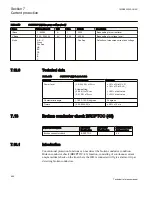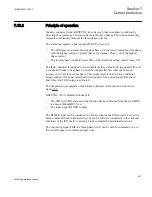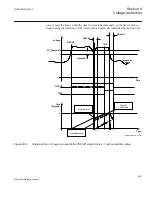
The lowest voltage is always used for the inverse time delay integration. The details of
the different inverse time characteristics are shown in section
.
Figure 248:
Voltage used for the inverse time characteristic integration
Voltage
IDMT Voltage
Time
VL1
VL2
VL3
ANSI12000186-1-en.vsd
Trip signal issuing requires that the undervoltage condition continues for at least the
user set time delay. This time delay is set by the parameter
t1
and
t2
for definite time
mode (DT) and by some special voltage level dependent time curves for the inverse
time mode (TUV). If the pickup condition, with respect to the measured voltage ceases
during the delay time, and is not fulfilled again within a user defined reset time
(
tReset1
and
tReset2
for the definite time and
tIReset1
and
tIReset2
pickup for the
inverse time) the corresponding pickup output is reset. Here it should be noted that
after leaving the hysteresis area, the pickup condition must be fulfilled again and it is
not sufficient for the signal to only return back to the hysteresis area. Note that for the
undervoltage function the TUV reset time is constant and does not depend on the
voltage fluctuations during the drop-off period. However, there are three ways to reset
the timer, either the timer is reset instantaneously, or the timer value is frozen during
the reset time, or the timer value is linearly decreased during the reset time. See
figure
and figure
Section 8
1MRK505222-UUS C
Voltage protection
494
Technical reference manual
Summary of Contents for Relion 670 series
Page 1: ...Relion 670 series Line differential protection RED670 ANSI Technical reference manual...
Page 2: ......
Page 40: ...34...
Page 50: ...44...
Page 60: ...54...
Page 126: ...120...
Page 384: ...378...
Page 496: ...490...
Page 556: ...550...
Page 602: ...596...
Page 620: ...614...
Page 794: ...788...
Page 864: ...858...
Page 988: ...982...
Page 998: ...992...
Page 1084: ...1078...
Page 1164: ...1158...
Page 1168: ...1162...
Page 1220: ...1214...
Page 1230: ...1224...
Page 1231: ...1225...
















































